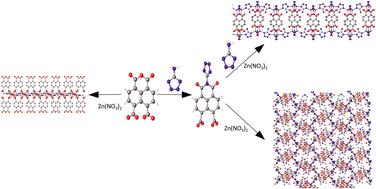当前位置:
X-MOL 学术
›
CrystEngComm
›
论文详情
Our official English website, www.x-mol.net, welcomes your
feedback! (Note: you will need to create a separate account there.)
Naphthalene-1,8-dicarboxylate based zinc coordination polymers: a photophysical study
CrystEngComm ( IF 2.6 ) Pub Date : 2024-01-30 , DOI: 10.1039/d3ce01233f Pablo Guerrero-García 1 , Javier Cepeda 2 , Mariano Ortega-Muñoz 3 , Jose Angel García 4 , Amparo Navarro 5 , Duane Choquesillo-Lazarte 6 , Sara Rojas 1 , Antonio Rodríguez Diéguez 1 , María Mar Quesada-Moreno 5 , Iñigo J. Vitórica-Yrezábal 1
CrystEngComm ( IF 2.6 ) Pub Date : 2024-01-30 , DOI: 10.1039/d3ce01233f Pablo Guerrero-García 1 , Javier Cepeda 2 , Mariano Ortega-Muñoz 3 , Jose Angel García 4 , Amparo Navarro 5 , Duane Choquesillo-Lazarte 6 , Sara Rojas 1 , Antonio Rodríguez Diéguez 1 , María Mar Quesada-Moreno 5 , Iñigo J. Vitórica-Yrezábal 1
Affiliation

|
Herein, we report the synthesis and photoluminescence properties of a new 1,3-dioxo-2-(1H-tetrazol-5-yl)-2,3-dihydro-1H-benzo[de]isoquinoline-6,7-dicarboxylic (H3L) ligand and three coordination polymers (CPs). Compound [Zn(ntca)DMF]n·DMF (1) (ntca2− = 1,4,5,8-naphthalenetetracarboxylate 1,8-monoanhydride, DMF = N,N-dimethylformamide) formed 1D coordination polymer chains packed by hydrogen bonding interactions. On its part, compounds namely [(CH3)2NH2](Zn2(μ-OH)(L)(5-NH2-tetrazolate)n·2H2O (2) and [(CH3)2NH2](ZnL)n (3) (where H3L stands for 1,3-dioxo-2-(1H-tetrazol-5-yl)-2,3-dihydro-1H-benzo[de]isoquinoline-6,7-dicarboxylic acid) crystallize as 2D-layered and 3D anionic frameworks containing dimethylammonium cations occupying the voids. Photoluminescence (PL) measurements have been performed in the solid state on all CPs and ligands to characterize their emission properties, including variable-temperature spectra, lifetime and efficiency. Moreover, the photophysical properties have been studied from the theoretical viewpoint by means of time dependent density functional theory (TD-DFT) in order to elucidate the mechanisms and electronic transitions governing the process. Compounds 1 and 3 present an intense blue luminescence which was originated in the electronic transitions of the ntca2− and the L3− ligands. Compound 2 displays a lower quantum yield which could be tentatively attributed to the weak π–π interactions of the aromatic clouds of L3− or the molecular vibrations and/or possible rotational motions of the 5-amino-tetrazolate co-ligand.
中文翻译:

1,8-萘二甲酸基锌配位聚合物:光物理研究
在此,我们报道了新的1,3-dioxo-2-(1 H -tetrazol-5-yl)-2,3-dihydro-1 H -Benz[de]isoquinoline-6,7-的合成和光致发光性质二羧酸(H 3 L)配体和三个配位聚合物(CP)。化合物[Zn(ntca)DMF] n ·DMF ( 1 ) (ntca 2− = 1,4,5,8-萘四甲酸1,8-单酐, DMF = N , N -二甲基甲酰胺)形成由氢填充的一维配位聚合物链粘合相互作用。就其本身而言,化合物为 [(CH 3 ) 2 NH 2 ](Zn 2 (μ-OH)(L)(5-NH 2 -四唑) n ·2H 2 O ( 2 ) 和 [(CH 3 ) 2 NH 2 ](ZnL) n ( 3 ) (其中 H 3 L 代表 1,3-二氧代-2-(1 H-四唑-5-基)-2,3-二氢-1 H-苯并[去]异喹啉- 6,7-二羧酸)结晶为 2D 层状和 3D 阴离子框架,其中含有占据空隙的二甲基铵阳离子。已在所有 CP 和配体上进行固态光致发光 (PL) 测量,以表征其发射特性,包括可变温度光谱、寿命和效率。此外,通过时间相关密度泛函理论 (TD-DFT) 从理论角度研究了光物理性质,以阐明控制该过程的机制和电子跃迁。化合物 1和3呈现出强烈的蓝色发光源自 ntca 2−和 L 3−配体的电子跃迁。化合物2显示出较低的量子产率,这可能暂时归因于 L 3−或L 3− 的芳香云的弱 π-π 相互作用5-氨基-四唑酯共配体的分子振动和/或可能的旋转运动。
更新日期:2024-01-30
中文翻译:

1,8-萘二甲酸基锌配位聚合物:光物理研究
在此,我们报道了新的1,3-dioxo-2-(1 H -tetrazol-5-yl)-2,3-dihydro-1 H -Benz[de]isoquinoline-6,7-的合成和光致发光性质二羧酸(H 3 L)配体和三个配位聚合物(CP)。化合物[Zn(ntca)DMF] n ·DMF ( 1 ) (ntca 2− = 1,4,5,8-萘四甲酸1,8-单酐, DMF = N , N -二甲基甲酰胺)形成由氢填充的一维配位聚合物链粘合相互作用。就其本身而言,化合物为 [(CH 3 ) 2 NH 2 ](Zn 2 (μ-OH)(L)(5-NH 2 -四唑) n ·2H 2 O ( 2 ) 和 [(CH 3 ) 2 NH 2 ](ZnL) n ( 3 ) (其中 H 3 L 代表 1,3-二氧代-2-(1 H-四唑-5-基)-2,3-二氢-1 H-苯并[去]异喹啉- 6,7-二羧酸)结晶为 2D 层状和 3D 阴离子框架,其中含有占据空隙的二甲基铵阳离子。已在所有 CP 和配体上进行固态光致发光 (PL) 测量,以表征其发射特性,包括可变温度光谱、寿命和效率。此外,通过时间相关密度泛函理论 (TD-DFT) 从理论角度研究了光物理性质,以阐明控制该过程的机制和电子跃迁。化合物 1和3呈现出强烈的蓝色发光源自 ntca 2−和 L 3−配体的电子跃迁。化合物2显示出较低的量子产率,这可能暂时归因于 L 3−或L 3− 的芳香云的弱 π-π 相互作用5-氨基-四唑酯共配体的分子振动和/或可能的旋转运动。





















































 京公网安备 11010802027423号
京公网安备 11010802027423号